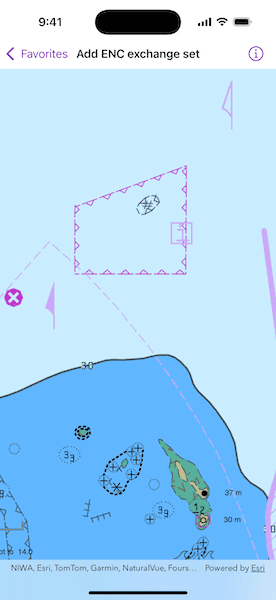Display nautical charts per the ENC specification.

Use case
The ENC specification describes how hydrographic data should be displayed digitally.
An ENC exchange set is a catalog of data files which can be loaded as cells. The cells contain information on how symbols should be displayed in relation to one another, so as to represent information such as depth and obstacles accurately.
How to use the sample
Run the sample and view the ENC data. Pan and zoom around the map. Take note of the high level of detail in the data and the smooth rendering of the layer.
How it works
- Specify the path to a local CATALOG.031 file to create an
ENCExchangeSet. - After loading the exchange set, get the
ENCDatasetobjects asynchronously. - Create an
ENCCellfor each dataset. Then create anENCLayerfor each cell. - Add the ENC layer to a map's operational layers collection to display it.
Relevant API
- ENCCell
- ENCDataset
- ENCExchangeSet
- ENCLayer
Offline data
This sample downloads the ENC Exchange Set without updates item from ArcGIS Online.
The latest hydrography package can be downloaded from Esri Developer website. The S57DataDictionary.xml file is contained in it along with many others but a user does not need to know that in order to render ENC data.
Tags
data, ENC, hydrographic, layers, maritime, nautical chart
Sample Code
// Copyright 2024 Esri
//
// Licensed under the Apache License, Version 2.0 (the "License");
// you may not use this file except in compliance with the License.
// You may obtain a copy of the License at
//
// https://www.apache.org/licenses/LICENSE-2.0
//
// Unless required by applicable law or agreed to in writing, software
// distributed under the License is distributed on an "AS IS" BASIS,
// WITHOUT WARRANTIES OR CONDITIONS OF ANY KIND, either express or implied.
// See the License for the specific language governing permissions and
// limitations under the License.
import ArcGIS
import SwiftUI
struct AddENCExchangeSetView: View {
/// The tracking status for the loading operation.
@State private var isLoading = false
/// The error shown in the error alert.
@State private var error: Error?
/// The data model for the sample.
@StateObject private var model = Model()
var body: some View {
MapViewReader { mapProxy in
MapView(map: model.map)
.overlay(alignment: .center) {
if isLoading {
ProgressView("Loading…")
.padding()
.background(.ultraThickMaterial)
.clipShape(.rect(cornerRadius: 10))
.shadow(radius: 50)
}
}
.task {
do {
isLoading = true
try await model.addENCExchangeSet()
if let extent = model.completeExtent {
await mapProxy.setViewpoint(
Viewpoint(center: extent.center, scale: 67000)
)
}
isLoading = false
} catch {
self.error = error
}
}
}
.errorAlert(presentingError: $error)
}
}
private extension AddENCExchangeSetView {
@MainActor
class Model: ObservableObject {
/// A map with Oceans style.
let map: Map = {
let map = Map(basemapStyle: .arcGISOceans)
map.initialViewpoint = Viewpoint(
latitude: -32.5,
longitude: 60.95,
scale: 67000
)
return map
}()
/// The geometry that represents a rectangular shape that encompasses the area on the
/// map where the ENC data will be rendering.
private(set) var completeExtent: Envelope?
/// A URL to the temporary SENC data directory.
private let temporaryURL: URL = {
let directoryURL = FileManager.default.temporaryDirectory.appendingPathComponent(
ProcessInfo().globallyUniqueString
)
// Create and return the full, unique URL to the temporary folder.
try? FileManager.default.createDirectory(
at: directoryURL,
withIntermediateDirectories: true
)
return directoryURL
}()
deinit {
// Recursively remove all files in the sample-specific
// temporary folder and the folder itself.
try? FileManager.default.removeItem(at: temporaryURL)
// Reset ENC environment display settings.
let displaySettings = ENCEnvironmentSettings.shared.displaySettings
displaySettings.textGroupVisibilitySettings.resetToDefaults()
displaySettings.viewingGroupSettings.resetToDefaults()
}
/// Gets the ENC exchange set data and loads it and sets the display settings.
func addENCExchangeSet() async throws {
let exchangeSet = ENCExchangeSet(fileURLs: [.exchangeSet])
// URL to the "hydrography" data folder that contains the "S57DataDictionary.xml" file.
let resourceURL = URL.hydrographyDirectory.deletingLastPathComponent()
// Set environment settings for loading the dataset.
let environmentSettings = ENCEnvironmentSettings.shared
environmentSettings.resourceURL = resourceURL
// The SENC data directory is for temporarily storing generated files.
environmentSettings.sencDataURL = temporaryURL
updateDisplaySettings()
try await exchangeSet.load()
try await renderENCData(datasets: exchangeSet.datasets)
}
/// Maps the exchange set data to ENC layer and ENC cells and loads the layers.
/// - Parameter datasets: The ENC datasets previously loaded.
private func renderENCData(datasets: [ENCDataset]) async throws {
let encLayers = datasets.map {
ENCLayer(
cell: ENCCell(
dataset: $0
)
)
}
map.addOperationalLayers(encLayers)
await encLayers.load()
let extents = map.operationalLayers.compactMap(\.fullExtent)
completeExtent = GeometryEngine.combineExtents(of: extents)
}
/// Updates the display settings to make the chart less cluttered.
private func updateDisplaySettings() {
let displaySettings = ENCEnvironmentSettings.shared.displaySettings
let textGroupVisibilitySettings = displaySettings.textGroupVisibilitySettings
textGroupVisibilitySettings.includesGeographicNames = false
textGroupVisibilitySettings.includesNatureOfSeabed = false
let viewingGroupSettings = displaySettings.viewingGroupSettings
viewingGroupSettings.includesBuoysBeaconsAidsToNavigation = false
viewingGroupSettings.includesDepthContours = false
viewingGroupSettings.includesSpotSoundings = false
}
}
}
private extension URL {
static let exchangeSet = Bundle.main.url(
forResource: "CATALOG",
withExtension: "031",
subdirectory: "ExchangeSetwithoutUpdates/ExchangeSetwithoutUpdates/ENC_ROOT"
)!
static let hydrographyDirectory = Bundle.main.url(
forResource: "S57DataDictionary",
withExtension: "xml",
subdirectory: "hydrography/hydrography"
)!
}